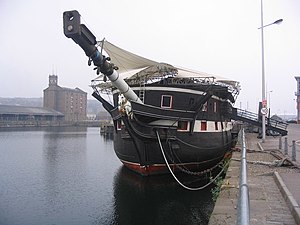
| |
| History | |
|---|---|
| Name | HMS Unicorn |
| Operator | Royal Navy |
| Ordered | 23 July 1817 |
| Builder | Royal Dockyard, Chatham, Kent, England |
| Laid down | February 1822 |
| Launched | 30 March 1824 |
| In service | 1824 |
| Out of service | ~1964 |
| Refit | 1824, refit during construction to receiving/barracks vessel |
| Homeport | Dundee, Scotland |
| Status | Museum ship, Dundee, Scotland |
| General characteristics | |
| Class and type | Modified Leda-class frigate |
| Tons burthen | 1077 bm |
| Length |
|
| Beam | 40 ft 3 in (12.27 m) |
| Depth of hold | 12 ft 9 in (3.89 m) |
| Sail plan | Although never given masts, she was planned as a full-rigged ship |
| Range | Cannot move without tow (never rigged) |
| Complement | 315 |
| Armament |
|
HMS Unicorn is a surviving sailing frigate of the successful Leda class, although the original design had been modified by the time that the Unicorn was built, to incorporate a circular stern and "small-timber" system of construction. Listed as part of the National Historic Fleet, Unicorn is now a museum ship in Dundee, Scotland, United Kingdom. She is the oldest ship in Scotland,[1] one of the oldest ships in the world,[1][2] and one of the last intact warships from the age of sail.[2][3]
- ^ a b Cite error: The named reference
ogstonwas invoked but never defined (see the help page). - ^ a b Brady, Jon (13 April 2019). "Historic HMS Unicorn gets £29k lottery cash ahead of 200th anniversary". Evening Telegraph. ISSN 0307-1235. Archived from the original on 14 April 2019. Retrieved 22 April 2019.
- ^ Breverton, Terry (2010). Breverton's nautical curiosities: a book of the sea. New York: Quercus. ISBN 9781623653200. OCLC 869301594.